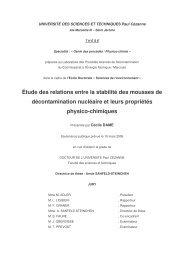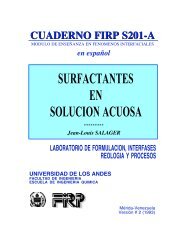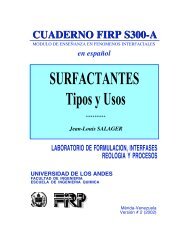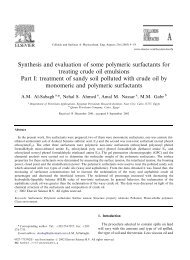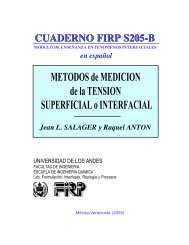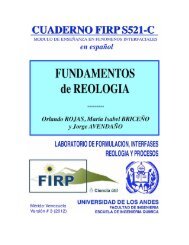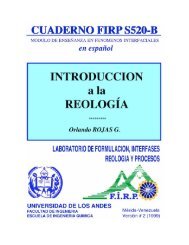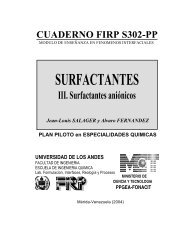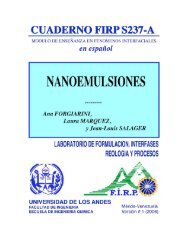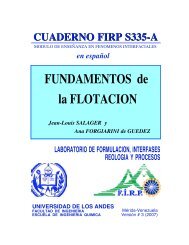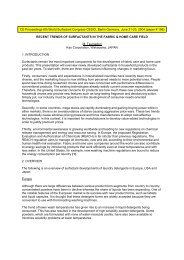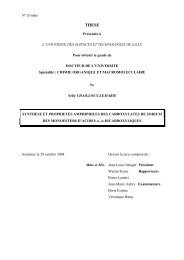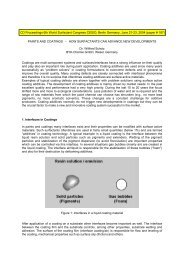Solubilization-emulsification mechanisms of detergency
Solubilization-emulsification mechanisms of detergency
Solubilization-emulsification mechanisms of detergency
Create successful ePaper yourself
Turn your PDF publications into a flip-book with our unique Google optimized e-Paper software.
C.A. Miller and K.H. Raney/Colloids Surfaces A: Physicochem. Eng. Aspects 74 (1993) 169-215 185<br />
phases, one may also calculate the relative<br />
velocities <strong>of</strong> all interfaces, and therefore the<br />
growth rates <strong>of</strong> intermediate phases. More<br />
detailed descriptions <strong>of</strong> the mathematical<br />
analysis and the specific error function solutions<br />
can be found elsewhere for a ternary system<br />
forming a single interface [63] or two or more<br />
interfaces [65].<br />
The utility <strong>of</strong> diffusion path theory in ternary<br />
liquid systems was first shown for predicting the<br />
occurrence <strong>of</strong> spontaneous <strong>emulsification</strong> in<br />
alcohol-water-oil systems [63]. Specifically,<br />
when an alcohol-oil mixture denoted d in Fig.<br />
17 is brought into contact with water,<br />
spontaneous <strong>emulsification</strong> <strong>of</strong> oil drops in the<br />
water phase is observed. In this situation, the<br />
construction <strong>of</strong> a diffusion path between the<br />
initial compositions shows the formation <strong>of</strong> an<br />
interface with equilibrium compositions b and c<br />
connected by the tie line represented by the<br />
broken line. Spontaneous <strong>emulsification</strong> in the<br />
aqueous phase can be explained by the passage<br />
<strong>of</strong> that path segment from b to W through the<br />
corner <strong>of</strong> the two-phase envelope, thereby<br />
predicting the formation <strong>of</strong> small drops <strong>of</strong><br />
oil-alcohol mixture below the interface.<br />
Experiments showed that, in the absence <strong>of</strong><br />
interfacial turbulence, interfacial displacement<br />
Fig. 17. Schematic diffusion path in alcohol(A)water(W)-oil(O)<br />
system showing supersaturation<br />
leading to spontaneous <strong>emulsification</strong>.<br />
is proportional to the square root <strong>of</strong> time, as<br />
predicted by the theory [65,66]. This diffusion<br />
mechanism <strong>of</strong> spontaneous <strong>emulsification</strong> is<br />
distinct from other modes <strong>of</strong> spontaneous<br />
<strong>emulsification</strong> in which interfacial instability<br />
results in the mechanical dispersion <strong>of</strong> one<br />
phase in another [67].<br />
Diffusion path analysis was later applied to<br />
oil-water-surfactant systems [20,64,68]. In these<br />
cases, the use <strong>of</strong> pseudoternary phase diagrams<br />
was required. For example, commercial<br />
surfactants are almost always complex mixtures<br />
containing numerous species <strong>of</strong> surfactants.<br />
Rather than solving the diffusion equations for<br />
each species, one can sometimes combine all<br />
surfactant components together and treat them<br />
as a pseudocomponent. Mixtures <strong>of</strong><br />
hydrocarbons can also be considered as<br />
pseudocomponents. Although diffusion path<br />
studies are typically performed when<br />
single-phase systems are originally present, the<br />
ability to calculate diffusion paths in which one<br />
<strong>of</strong> the initial compositions is a stable dispersion<br />
<strong>of</strong> one phase in another, e.g. a liquid crystalline<br />
dispersion, has also been demonstrated [64].<br />
5. Dynamic contacting studies<br />
Direct observation <strong>of</strong> the dynamic phenomena<br />
that occur when non-equilibrated liquid phases<br />
are brought into contact can be made in various<br />
ways. On a macroscopic scale, a liquid can be<br />
gently placed on top <strong>of</strong> another liquid in a tube,<br />
and rather large-scale phenomena can be<br />
observed. This simple technique was used in the<br />
early studies <strong>of</strong> spontaneous <strong>emulsification</strong> in<br />
oil-water-alcohol systems [63] and has been<br />
used with surfactant systems to monitor the<br />
formation <strong>of</strong> microemulsion and liquid<br />
crystalline phases between oil and surfactant<br />
solutions [68-71]. In these cases, the oil is<br />
gently layered on top <strong>of</strong> the aqueous phase, and<br />
dynamic phenomena are observed without<br />
magnification. Crossed polarizers aid in the<br />
identification <strong>of</strong> birefringent liquid crystalline<br />
phases. A shortcoming <strong>of</strong> this technique is the<br />
inability to observe events which occur<br />
immediately after the contacting <strong>of</strong> the two



